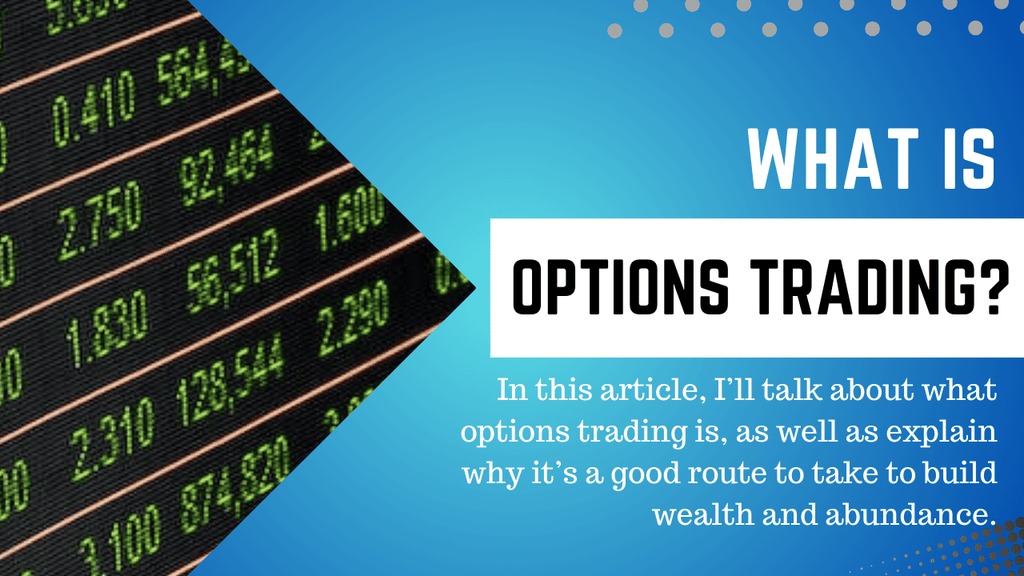5 Steps to Start Options Trading and Get Better Results

In working toward building financial abundance, investing is one piece of the puzzle worth exploring, especially options trading.
Most people are somewhat familiar with trading in general, but options trading is one way to invest with lower risk.
In this article, I’ll talk about what options trading is, including 5 steps to get started and why it’s a good route to take to build wealth and abundance.
What Is Options Trading?

In short, options trading is pre-negotiating a certain price by a certain date for all buying and selling of stocks or assets of any kind.
It’s a pretty complex way to do things because it’s important for you to have an understanding of advanced strategies, even if you have a broker do the heavy lifting.
In addition, opening an options trading account has a few more steps than your run-of-the-mill investment account.
Though you could lose your shirt if you don’t set things up right, the point of buying options is in the hope that you don’t need them. They are there just in case.
You have put options and call options…
A put option is a contract that gives you the right to sell a stock or shares at a predetermined price before the contract ends without the obligation to sell.
A call option is a contract that gives you the right to buy a stock at a predetermined price in a predetermined time frame without the obligation to buy it.
Don’t know if options trading is right for you? Check out my article 13 Most Profitable Online Businesses to Start in 2024 to see other businesses you could start.
How to Trade Options in Five Steps
Step 1: Open an Options Trading Account
As I stated above, this is more complex than a regular investment account.
You need to prove you’re up to the task and know what you’re doing.
It’s a time investment as well as a capital investment. You need to take the time to watch the market and know what’s going on.
You need to provide some information before a broker will agree to work with you.
This information includes your trading experience, understanding of the risks, and your financial preparedness to invest. You’ll also be asked what types of options you want to trade.
But be sure to look into the broker as well. It’s a two-way street. You don’t want to end up with someone who doesn’t know what they’re doing.
Step 2: Choose the Options You Want to Buy or Sell

A good rule of thumb is if you think the stock price will go up, either buy a call option or sell a put option.
If you think the price will stay about the same, sell a call option or a put option.
And if you think the price will drop, buy a put option or sell a call option.
It seems simple, but it takes time to study the market and make educated predictions.
Step 3: Predict the Option Strike Price
A strike price is a predetermined price.
You want to choose your options based on when you think you’ll be in the money by the end of the option time frame.
For example, for call options, you want to be above the predetermined price and for put options you want to be below the set price.
Step 4: Choose the Time Frame for the Option
Every contract has a deadline of when you can use the option. There are dates offered to you when you set the contract.
Options expiration dates can be days, months, or even years. The least amount of time, daily or weekly for example, are the riskiest.
If you don’t have a lot of experience with options trading, setting monthly or yearly expiration dates are best.
It’s also advantageous to have a longer option expiration date because it gives the stock more time to move and do what you predicted.
It gives you time to make your move: either to buy or sell, depending on if you have a call or put option.
Step 5: Decide What to Do with Your Earnings
Will you cash out? Or will you reinvest?
Assuming you are profitable in your investing (which is the hope), you can choose what to do with the extra money you make.

This is the fun part…enjoy it however you choose.
Why Options Trading?
Options trading protects your downsides. Even when the market isn’t going up or the market is volatile, you can still generate some income.
It’s kind of like having insurance, just in case something happens.
With options trading, you have great potential for large gains with limited losses. They can be a way to leverage and hedge your risks.
Want to know more about options trading? Check out Fidelity’s free course.
In a Nutshell
Options trading is a great alternative way to invest and profit from trading.
Get an idea of what the market is doing, have some capital to start, and hire a great broker and you’ll be in good shape.
With calls and puts, you have more control over what your money does in the stock market and how to hedge your risks.
It’s a game plan for investors wanting a little more control and great results.
